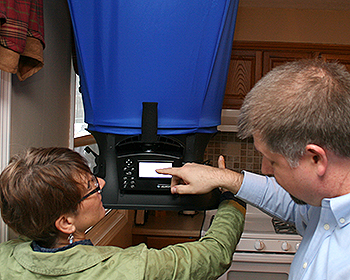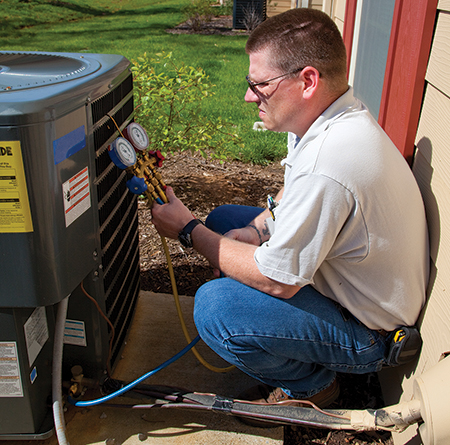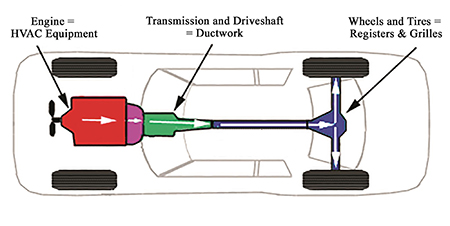
Dominick Guarino
If you’re on the fence about making your company more Performance-Based, this multi-part series can provide a lot of information to help you decide whether to invest in this innovative approach.
This series can also serve as a good refresher for those who have already embarked on the journey, but perhaps are not moving as fast as they want to, or have not been able to implement it as successfully as they would like.
More than 15 years ago National Comfort Institute (NCI) coined the term, ‘Performance-Based Contracting?’ to describe a different way of going to market. How was it different? Performance-Based Contracting revolves around testing pressures, airflow, and temperatures.
After testing and diagnosing a system you can provide a delivered efficiency score to help your customer understand how well their system is performing and how you can improve it.
The Genesis of High-Performance HVAC
The Performance-Based approach didn’t happen overnight. It’s the result of a buildup towards delivering true system performance that began more than 25 years ago. I personally wrote about the early signs of this shift back in 1992 as chief editor of an HVAC industry magazine in an editorial titled, ‘The Comfort Revolution.’
In the editorial I challenged the industry’s narrow focus on just selling energy ef’cient equipment. This paradigm resulted from the energy crisis of the late 1970s into the 1980s.
The article called for a shift back towards what our industry is all about in the ‘rst place: to keep indoor spaces comfortable year-round. The piece described how the industry had been derailed from its focus on comfort, health and safety, and became virtually obsessed with ‘energy ef’ciency.’ And even at that, the focus was erroneously on ‘box’ ef’ciency, namely SEER and AFUE, which only plays a part in true ‘delivered’ ef’ciency.
Equipment VS System Efficiency
Our industry’s ‘equipment ef’ciency’ focus continued into the next two decades, and is still prevalent today. Manufacturers continued to produce higher ef’ciency equipment, which is what you’d expect them to do, However, most contractors did not step up their game to improve ‘systems’ to

If you don’t measure, you’re just guessing. Customer involvement in the testing process helps separate Performance-Based Contractors’ from their competition. It also helps close more sales!
make the most of that better equipment.
As manufacturers strive toward even higher ef’ciency ratings, some have kept up the quality of their equipment with robust motors and fans that can to handle the higher static pressures created by more restrictive ‘high ef’ciency’ evaporator coils, denser air cleaners and ‘lters, and undersized ductwork.
Some however, still skimp on the capacities of their fans to keep perceived energy use down so they can meet AHRI SEER ratings. This makes it virtually impossible for many systems to deliver optimum comfort and energy ef’ciency.
With 13-14 SEER as the minimum ef’ciency standards (depending on region), for air central air conditioners and heat pumps, there’s very little differentiation based on ‘box’ ef’ciency in the eyes of the consumer. Consumer sales pitches based on ‘Return on Investment? (ROI) and payback from higher SEER equipment are less effective as contractors become hard-pressed to justify the extra cost.
Real Differentiation
High quality workmanship can be a signi’cant difference between contractors bidding on a job, But everyone claims they do high quality work, right? Don’t you?
So how do you differentiate yourself in this fast-changing environment that makes differentiation tougher than ever? What’s the next frontier? How can you prove to a customer you are truly different?
Here’s how: provide them with documented and measured performance readings before you get the job and after the work is completed.
After all, if you don’t measure, you’re just guessing!
The process is fairly simple: teach your customers about their systems in simple terms, pointing out real problems, Then ‘prove’ your work is superior through documentation.
What’s interesting about measuring and delivering system performance is it allows you to truly do just that: deliver the best system with optimized safety, comfort, and energy ef’ciency. There’s no need to compromise any of these three components of system performance to achieve one or both of the others.
As you read this series, it will become clear that your customer can have it all, and so can you. Performance-Based Contracting can also provide the double-digit net pro’t margins you deserve and need to be successful over the long run.

Equipment efficiency and system efficiency are not the same thing. If you only check the equipment, you’re ignoring the air delivery system’ and that will negatively impact ‘delivered’ efficiency.
What Is High Performance HVAC Contracting?
Although many aspects of High Performance Contracting involve changing the very core of how an HVAC contractor does business, the basic premise is: Deliver Measured Performance.
If this was all you had to know, this article would end here and you could implement this concept and become tremendously successful. If it were that easy, everyone would be doing it and it would become a commodity in no time.
Fortunately for you, it’s not that simple.
High-Performance Contracting involves a series of signi’cant changes in how you manage and operate your contracting business. Sure, the technical aspects of delivering measured performance are important and critical, but the technical side is just one facet of this approach.
The Components of High-Performance Contracting
Let’s break down some of the basic precepts of High-Performance Contracting to better explain the culture change needed to effectively transform an organization into a Performance-Based business.
On the technical side, it requires in-depth knowledge of true HVAC system performance, from how you ‘eld-design your systems, to how you install and test them to make sure they safely and ef’ciently deliver the comfort you promised. This also applies to how you service and maintain systems as well. To become Performance-Based you must pull your head out of the box and look at the entire system, from the equipment to the duct system, to the grilles and registers that deliver air into the space.
Equipment Performance
From an equipment perspective, performance entails proper sizing and installation. It requires understanding fan characteristics and the effects of coils and ‘lters on air ‘ow. In addition, it means properly charging the refrigerant side of the system once you have corrected air side problems. This requires checking and adjusting important readings like superheat and subcooling for optimum equipment performance.
High Performance Contracting also requires a better understanding of combustion from three aspects: Safety, as it relates to the dangers of carbon monoxide; Ef’ciency, as it relates to getting the most BTUs from the burners transferred to the air stream; and Comfort, as it relates to maintaining warmer discharge temperatures.
But that’s only the beginning. To become Performance-based, you need to understand that the equipment — air handlers, furnaces, and condensing units — are just components of a system, not the system itself.

Using a car analogy to explain how an overall HVAC system works helps customers to better understand their system and more open to upgrades and repairs.
An Automotive Analogy
Comparing an HVAC system to an automobile can be a very powerful analogy — especially for customers.
The equipment (air handler, furnace, condensing unit), is similar to the engine that powers the vehicle. It’s the heart of the system. The transmission can be compared to the duct system. The wheels can be compared to the grilles and registers.
Unless you have a properly working transmission, along with good wheels and tires, you won’t get the mileage and performance you expect from your car. In fact it may not work at all.
An auto transmission is much like an air distribution system ‘ it delivers the power from the engine to the wheels. The duct system delivers the cooled or heated air from the equipment to the grilles and registers, and ultimately into the spaces you want to make comfortable.
As you begin to truly look at system performance in a different light, you’ll come to understand that our industry has missed the mark for many decades, as we’ve been led to believe that equipment alone delivers performance and comfort.
We’ve also been led to believe that if you design a duct system according to industry standards, it will work without testing or adjusting.
High-Performance Contracting essentially helps you get back to the roots of what your company is in business for in the ‘rst place ‘ to deliver optimum indoor comfort safely and ef’ciently.
Be sure to look for the next installment in this series where we will explore the steps needed to move an HVAC contracting business into the High Performance zone.












Recent Comments